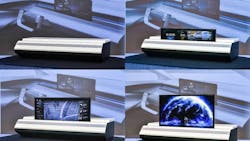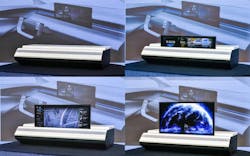World’s First Automotive Rollable Display Debuts
This article is part of the TechXchange: Advanced Display Technology.
According to the "Automotive Digital Cockpit Global Market Report 2023" (The Business Research Company), the global automotive digital cockpit market will grow from $21.13 billion in 2022 to $23.71 billion in 2023, representing a compound annual growth rate (CAGR) of 12.2%.
For product proliferation to occur at this predicted level, technological improvements are needed to make it possible to create smaller, more flexible displays that can be placed anywhere in the vehicle. This would provide the needed flexibility in automotive interior design.
To that end, Hyundai Mobis together with LG Display have developed what they claim is the world's first rollable display for vehicles.
Depending on the driving mode, the screen size can be unfurled to over 30 inches and features four driving modes with different screen sizes in quad high-definition (QHD) resolution. QHD is a resolution standard for monitors, televisions, and mobile devices specified as 2560 × 1440 pixels at a 16:9 aspect ratio, 4X that of 720p standard high definition.
The rollable display features a screen that rolls up and down when displaying driving information, including navigation. The screen disappears into its housing when the engine is turned off.
When parked or charging an electric vehicle containing the rollable display, the display is fully unrolled to a 16:9 ratio to show videos. The company said it can make large displays of 30 inches or more.
When driving, users can roll the screen up to one-third to show only the minimum driving information required. The Hyundai Mobis display is scaled up to two-thirds when using navigation.
The display takes up a minimal amount of space, which, in turn, is expected to significantly improve automotive interior design. Not only can it be installed around the driver's seat, but it’s also able to be mounted so that the screen comes down from the ceiling between the front and rear seats in purpose-based mobility (PBV) mode for leisure or family passengers.
In most cases, the rollable display will be placed where the navigation system is currently installed.
The biggest feature of the rollable display is its lightweight structure, which takes up minimal volume. It requires a mere 12 cm (approximately 4.7 in.) of depth to be installed near the driver's seat.
Han Young-hoon, Vice President, Head of Electronics Convenience and Control (EC), Hyundai Mobis, said "We are looking forward to becoming a game changer in the automotive display market with our differentiated technology.”
According to Hyundai Mobis, about 50 core technologies related to rollable displays are in the process of being patented at home and abroad, mostly focusing on the infotainment capabilities and the development of instrument clusters.
Read more articles in the TechXchange: Advanced Display Technology.

